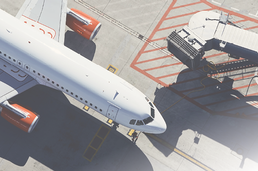Seamless Customer Experience at Airports
- 2024-09-23

Smart Transportation, Enterprise Business Group from Huawei International
Airport operators play a crucial role in facilitating a seamless customer experience by leveraging efficient operations and technology to increase revenue. Despite existing connectivity solutions, passengers can sometimes face issues with staying connected, impacting their overall experience. Adrien Tay, Chief Technology Officer, Smart Transportation writes how Huawei offers solutions to provide ubiquitous coverage, high-quality connections and seamless roaming to enhance passenger satisfaction across airport touchpoints.
Airport operators today have an important role to play in passenger facilitation and customer experience. Efficient airport operations support airports in achieving revenue and on-time performance targets. With the latest technologies used in passenger facilitation, airports can increase the dwell time, thus increasing the chances of conversions leading to more non-aeronautical revenue.
With more dwell time, passengers have sufficient time on their hands to experience the airport ambiance, try out local food, buy souvenirs and splurge on duty free goods at the airport. This is the chance for airport operators to shine, creating memorable experiences and increasing airport commercial revenue. One key component of being an amazing host is ensuring that passengers are able to stay connected, while they make their way around the airport.

Although Internet connectivity is in place for security and mission-critical airport operations, it may not be available in some other areas.
As an IT professional, I know the backbreaking work that airport IT undertakes to guarantee stable Internet connectivity for operations users, office users and mission-critical applications. So, for a different angle, let’s examine this from the lens of a typical passenger.
As a frequent traveler myself, I have fond memories of spending time at airports throughout the world. There was a trip which I remember like it was yesterday. It was my first business trip abroad in a new organization. Being new to the company, I was unsure of the travel policies and hence I intended to purchase a local sim card there instead of using cellular roaming.
Based on my confirmed flight schedule, I would land at 09:30am, next an online meeting at 10:30am, followed by lunch meeting in the city center. The schedule was well spaced out for the first day and the team meeting would be online which I could attend at the airport. It seems perfect, what could possibly go wrong?

The plane landed on time at 09:30am and it took 15 minutes to taxi to the stand. The cabin doors opened at 09:50am. I was still early. Everyone instinctively turned their cellphones on, I did so too. I searched for the free airport Wi-Fi and voilà…I was connected. First thing I did was to connect to my favorite online radio and check for any urgent messages or missed calls from the office.
It soon dawned on me that there was a bus ride before I could get to the immigration hall. Two escalator rides and a leisurely walk later, I was at a holding area waiting for the airside shuttle bus. While waiting, I wanted to check my emails and realized I was disconnected. I searched again for the free airport Wi-Fi and reconnected.
The airside bus arrived and I hopped on. Soon, we were on our way but somehow the music stopped. My phone was disconnected. There was no Wi-Fi onboard the bus.
The bus pulled up at the terminal, and I was a mere five minutes away from the immigration hall. At that point, it was 10:25am and I tried to connect to that important meeting, while waiting for my turn to get to border control.
Once connected, I was in the online meeting, waiting for the meeting to start. Another huge crowd had arrived, adding on to the queue. A couple of minutes in the queue, I lost audio, I could see the screen but could not hear my colleagues speaking. But it was easy, I reconnected again.

After clearing border control, I was off to collect my luggage at the baggage reclaim. Since it was a huge airport, it was located at a separate terminal. Hence, we were herded off to a train station to wait for an automated people mover. While waiting for the train, I managed to hear some of the discussions during the meeting.
The train came. With my luggage in one hand and phone in another, I boarded the train. Amidst all this, I was still connected to the conference, and I was next in line to speak in the meeting. My colleague was just finishing up. The train doors closed…and I was still listening on attentively to the meeting. As the train departed, I lost audio again, I saw that my colleague had stopped sharing his screen. It was my turn to speak. Again, the network connection dropped.

When the train arrived at the terminal, I was reconnected and tried to speak. At this point, I realized I had missed my turn and other colleagues went ahead to present their updates instead.
In a twinkling, I was at the baggage reclaim and it crossed my mind that I had to book a ride to the city center. However, I was still in the conference meeting. Hence, I walked to the departure hall and out to the curbside to assess the situation at the taxi queue. Upon walking out, I noticed there was no network outside. So, I retreated back into the terminal to remain connected to the online conference. When I rejoined the meeting, it had ended.

Although this is not representative of all airports and of all passenger experiences, admittedly, it still does happen in some of the best airports. What can airports do to ensure their passengers are able to stay connected and still enjoy themselves while going through the many touchpoints.
Imagine an intelligent Internet network that is able to assess the situation, monitor the service quality and provide the right quality connection to the passengers, who are our valued customers.
(Click to watch the video)
Reach out to your trusted ACI WBP partner Huawei who has experience providing connectivity solutions to global aviation clients. Huawei has a focused team of industry professionals and tech consultants familiar with aviation business operations, understand connectivity and can help you evaluate your airport network to design the best technical architecture to ensure ubiquitous coverage, high quality secure connection and seamless roaming.
Huawei has a wide portfolio of AirEngine Wi-Fi 7 systems for indoor or outdoor uses. Indoor systems could be used in the terminals and offices. Outdoor systems could be used to support airside applications such as to beam video footage from trains, stations and buses to the airport security.

Ubiquitous coverage enables connectivity throughout the airport, including terminals, walkways, escalators, lifts, buses, trains and the airside area. This ensures passengers can be connected anywhere and everywhere. AirEngine has built-in dynamic smart antennas which have both an omnidirectional or high-density coverage mode. The former ensures wider coverage, covering the toughest corners in the airport, while the latter maximizes performance and optimizes user experience in peak hours.
High quality connection considers the total number of passengers and devices in the terminal and how much bandwidth each passenger needs to accomplish their tasks. AirEngine can segregate different users out to allocate and guarantee service levels accurately according to their user profiles, job scope and service levels.
Seamless roaming means that passengers can roam between different Access Points (AP) as they are moving between touch-points in the airport. All this intelligent technology works in the background without troubling the passenger or airport IT.
To ensure data security, Huawei AirEngine integrates wired and wireless security measures and provides comprehensive security protection. With strict authentication and encryption, the system continuously monitors for rogue devices, encrypts data and protects users and the airport network.
Adrien Tay is the Chief Technology Officer of Smart Transportation, Enterprise Business Group from Huawei International, supporting digital transformation projects in the Asia Pacific region.
With more than 23 years of experience in the tech industry, supporting transport clients, Mr Tay possesses experience across technologies such as Connectivity, 5G, RFID, Cloud, IoT, Big Data and AI.
With the support of Huawei’s Smart Transportation solutions, Mr Tay is helping transport CxOs to improve their operations, meet safety standards, and create better passenger experiences.

This article was provided by a third party. The views expressed in the article do not represent or reflect the views of ACI Asia-Pacific & Middle East. Inclusion of any link to other external sites does not imply endorsement by ACI Asia-Pacific & Middle East of those sites and ACI Asia-Pacific & Middle East shall not be held responsible or liable for any content, advertising, products or other materials on or available from such external resources and sites.
- CATEGORY
- COUNTRY / AREA
- Hong Kong SAR
- AUTHOR
- Mr. Adrien Tay, Chief Technology Officer of Smart Transportation, Enterprise Business GroupHuawei International










